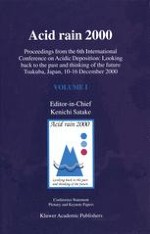2001 | OriginalPaper | Buchkapitel
Effects of Site Selection Strategy on Freshwater Critical Load Exceedances in Wales
verfasst von : C. J. Curtis, R. Harriman, M. Hughes, M. Kernan
Erschienen in: Acid rain 2000
Verlag: Springer Netherlands
Enthalten in: Professional Book Archive
Aktivieren Sie unsere intelligente Suche, um passende Fachinhalte oder Patente zu finden.
Wählen Sie Textabschnitte aus um mit Künstlicher Intelligenz passenden Patente zu finden. powered by
Markieren Sie Textabschnitte, um KI-gestützt weitere passende Inhalte zu finden. powered by
Critical loads are used in international negotiations to reduce acid deposition resulting from emissions of sulphur and nitrogen compounds within Europe. For freshwater ecosystems, the First-order Acidity Balance (FAB) model is used to generate national maps of critical loads and exceedances for both sulphur (S) and nitrogen (N). In Wales, two survey datasets have been used to calculate critical loads and exceedances; one based on water bodies selected to be “mostsensitive” to acidification within a 10 km grid and the other based on a random selection of standing waters. Both datasets indicate that critical loads were exceeded in 1990 in a significant proportion of Welsh lakes and streams; 36% of sites in the grid-basea survey and 31% of sites in the random survey. However, implementation of the Gothenburg Protocol would protect all but 6% of sites in the grid-based survey and all sites in the random survey. Assessment of the relative success of the Gothenburg Protocol in protecting Welsh freshwater ecosystems therefore depends on the site selection strategy employed.
